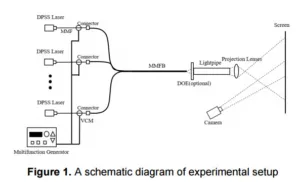The characterization of speckle is an on-going area of development and becoming more critical as laser-based projection systems expand beyond their initial deployments in digital cinema. There were four papers in session 10 on laser speckle, which we summarize below.
Junichi Kinoshita of Osaka University explained their way of describing speckle as a combination of red, green and blue speckle in RGB laser displays solutions. They call this color speckle theory which says that the speckle of each color is spread over the chromaticity diagram and can be analyzed by looking at this distribution of dots. The wider the distribution of the dots, the higher the speckle contrast.
The paper described the first time the researchers have used experimental data to try to validate this theory. In their mathematical formulation, the speckle contrast of the red, green and blue components can be measured or modeled independently. This can allow an analysis of the contributions of each color to the total speckle contrast.
They used the model to look at a laser-phosphor solution with a blue laser diode. This creates a “line” of speckle dots running the blue primary to a point halfway between the red and green primaries in the CIE diagram (left diagram). Using equal speckle contrast is shown in the center diagram and much lower speckle contrast in the right diagram.
Not unexpectedly, the team found that green speckle has the most impact on overall speckle with red and blue form only a minor part.
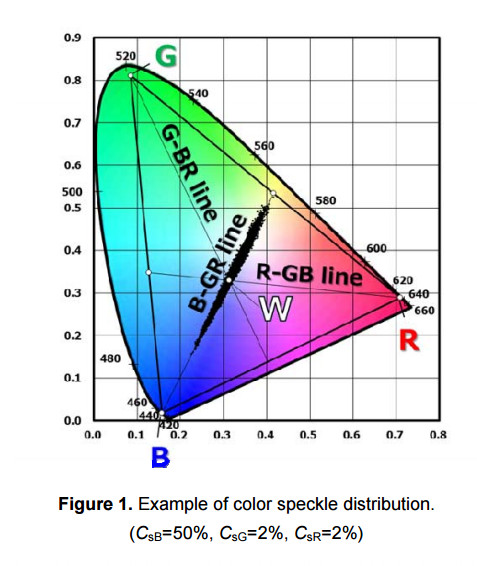
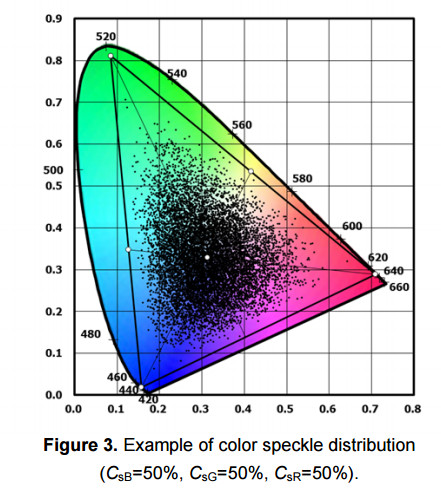
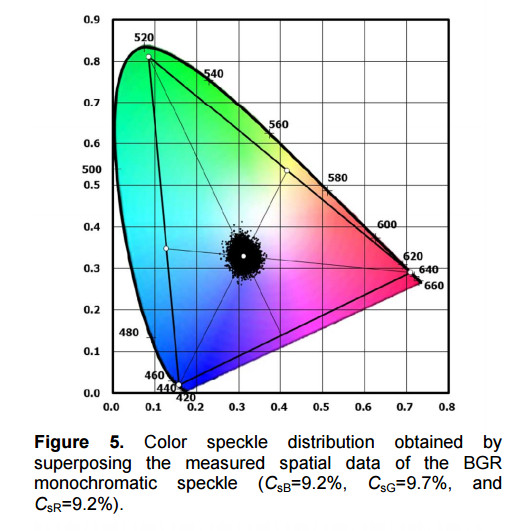
The second paper presented by Keizo Ochi of Konica Minolta, was designed to provide details on the experimental validation of the color speckle theory put forth by Professor Kuroda and explained by Kinoshita in the first paper.
Three conditions were measured. Conditions 1 and 2 featured red (647nm), green (532nm) and blue (460nm) laser light with a single longitudinal mode and spectral line width of less than 20 Mhz for the high coherency mode. Condition 1 used a linear polarizer and condition 2 eliminated it. Condition 3 used a prototype RGB laser projector with red at 638nm, green at 533nm and blue at 465nm that was able to generate various levels of speckle.
A diffuse target was illuminated by the laser light and Konika CA-2500 luminance meter with XYZ filters, an extra 1mm aperture (to simulate the eye) and a 1 million pixel CCD imager was used to capture data.
The team measured the speckle for the three conditions and plotted it on the CIE diagram and compared it to the simulated results per the color speckle theory described above. The results of condition 3 are shown in the chart below, which provide very good correlation with theory. Similar results were found for Conditions 1 and 2 as well.
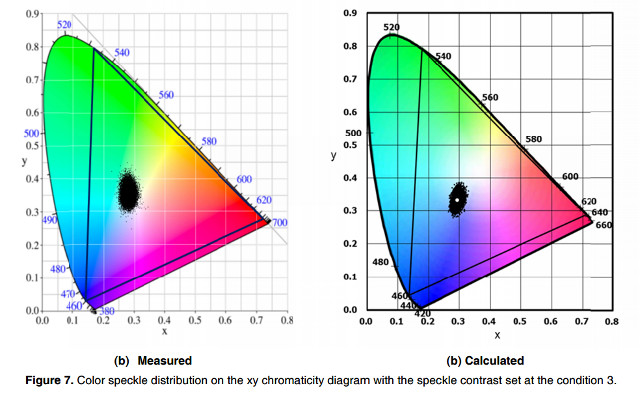
The absolute results will change if the measurement conditions (distance, angle apertures, laser wavelengths) change as well, but the technique holds promise as a fast alternative method for RGB laser speckle measurement. For example, the team now wants to see if their results correlate well with what human subjects actually perceive for speckle contrast.
Yanning Zhao from Visteon Electronic GmbH started out by defining objective speckle measurement as the type done without a lens and subjective as one done with a lens – as this mimics the human’s eye’s perception of speckle. She noted that speckle contract measurement is tricky with no set standard. Results will depend upon the camera focus, F-number, camera position and camera integration time. It is also dependent upon the content, as motion content is perceived to have less speckle than still image content.
Her paper focused on a new practical method of speckle measurement for projection systems. But several questions after her presentation cast doubt on the validity of her test set-up and results.
Finally, Qianli Ma of McMaster University in Toronto provided an analysis of speckle in narrow line width lasers. McMaster professor CQ Xu is the co-founder of Nanjing CQ Laser, a developer of diode-pumped solid state green lasers (DPSS). These frequency-doubled lasers have a narrow spectral line width – hence the motivation for the paper.
Nanjing CQ Laser is developing high power laser sources that can be used for digital cinema applications. To reduce speckle, they first fiber couple the lasers and then add some mechanical vibration of the fiber to further reduce speckle. Since there are multiple lasers/fiber combinations in the bundle, this interference can further reduce speckle, but the relationship between the number of fiber-coupled laser and speckle reduction has not been studied, which the paper explored.
The set up for the experiment is shown in the schematic below:
The VCM is a voice coil motor that vibrates the laser fiber at 50Hz with an amplitude of 0.5mm in the vertical direction. An optional diffractive optical element can be used as an additional diffuser at the input to the light pipe. To mimic the human perception of speckle, they carefully chose the camera setting (50mm focal length lens at F/16 and 1/15s integration time.)
The results are shown below;
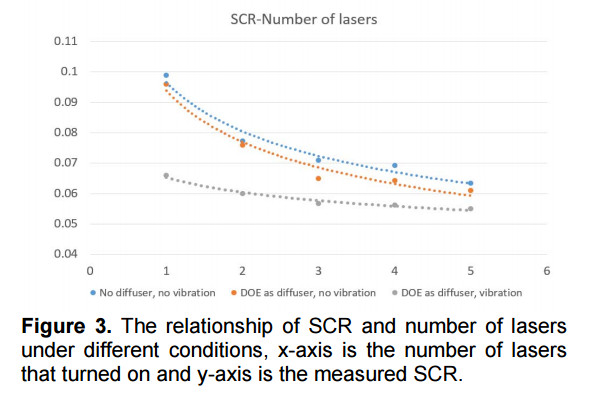
The results suggest that the diffuser adds a small amount of speckle reduction, but its impact grows with the number of lasers. Adding vibration has a larger impact on speckle reduction for a small number of laser/fiber sources and its impact decreases with more lasers. Both effects seem to be leveling off after 5 laser/fiber devices are combined.
Ma acknowledged that these results are still not yet acceptable for commercial applications where a speckle contrast level closer to 3% is needed. – CC

